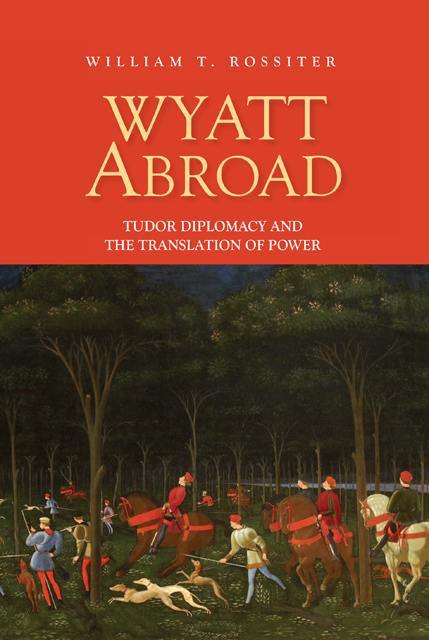Book contents
- Frontmatter
- Contents
- List of Illustrations
- Acknowledgements
- Note on Editions Used
- Abbreviations
- Introduction: The First Reformer?
- Chapter 1 ‘Sovendra du chaseur’: Wyatt in France, French at the English court
- Chapter 2 ‘My galy charged’: Wyatt in Italy
- Chapter 3 ‘So feble is the threde’: Wyatt in Spayne
- Chapter 4 ‘Inward Sion’: Wyatt in Jerusalem – The Penitential Psalms and Soteriological Diplomacy
- Conclusion: ‘In Kent and Christendome’: Wyatt in England
- Glossary of Rhetorical and Literary Terms
- Bibliography
- Index
Chapter 1 - ‘Sovendra du chaseur’: Wyatt in France, French at the English court
Published online by Cambridge University Press: 23 February 2023
- Frontmatter
- Contents
- List of Illustrations
- Acknowledgements
- Note on Editions Used
- Abbreviations
- Introduction: The First Reformer?
- Chapter 1 ‘Sovendra du chaseur’: Wyatt in France, French at the English court
- Chapter 2 ‘My galy charged’: Wyatt in Italy
- Chapter 3 ‘So feble is the threde’: Wyatt in Spayne
- Chapter 4 ‘Inward Sion’: Wyatt in Jerusalem – The Penitential Psalms and Soteriological Diplomacy
- Conclusion: ‘In Kent and Christendome’: Wyatt in England
- Glossary of Rhetorical and Literary Terms
- Bibliography
- Index
Summary
Digging Up The Past
In 1532 the French poet Maurice Scéve, inspired by Petrarch’s scattered rhymes, went in search of Laura, and apparently found her, in a tomb in Avignon. The skeletal remains of Laura de Sade, Petrarch’s alleged innamorata, were accompanied in the tomb by a dubious sonnet which could be deciphered by Scéve alone due to its age – Laura, as Petrarch records, having died in 1348. The King of France, Francis I, was so taken by this discovery that he re-enacted the exhumation shortly afterwards, opening the tomb and reading the sonnet himself, an obvious testament to the king’s own humanist credentials and literary sophistication. However, as Sara Sturm-Maddox has argued, ‘The royal enthusiasm … was no doubt also explained in part by cultural politics, in that Scéve’s discovery again called the attention of his contemporaries to the ways in which the revered Tuscan poet of the Rime was a poet of France.’
Four preliminary comments can be made concerning Scéve’s discovery. The first is that in travelling to Avignon and (literally) unearthing Laura and her text, Scéve was enacting the kind of humanist archaeology of knowledge which Petrarch himself had initiated with his discovery of Cicero’s Pro Archia and Letters to Atticus at Liège and Verona in 1333 and 1345 respectively. The second comment is that Scéve evidently was inspired by Alessandro Vellutello’s 1525 edition of Petrarch’s vernacular works, which was prefaced by a biographical account of Petrarch and the identification of Laura as Lauretta Chiabau, daughter of Anri Chiabau, quondam lord of Cabrières, which information Vellutello allegedly found in the Avignon parish register (her baptism was recorded on 4 June 1314): ‘laquale fu figliouola d’uno Anri Chiabau, Signore allhora di Cabrières, & batezzata l’anno Mcccxiiii, a di quattro di giugno’. It was this same edition, as will be discussed further in the following chapter, that shaped Wyatt’s Petrarchan hermeneutics. The third comment is that the politicization of the Petrarchan bonanza by Francis is consonant with the politicization of Petrarch by Wyatt and his contemporaries in England in the previous decade, which leads us to the fourth, perhaps most important point. Wyatt’s earliest forays into Petrarchism began in the mid to late 1520s.
- Type
- Chapter
- Information
- Wyatt AbroadTudor Diplomacy and the Translation of Power, pp. 47 - 89Publisher: Boydell & BrewerPrint publication year: 2014

